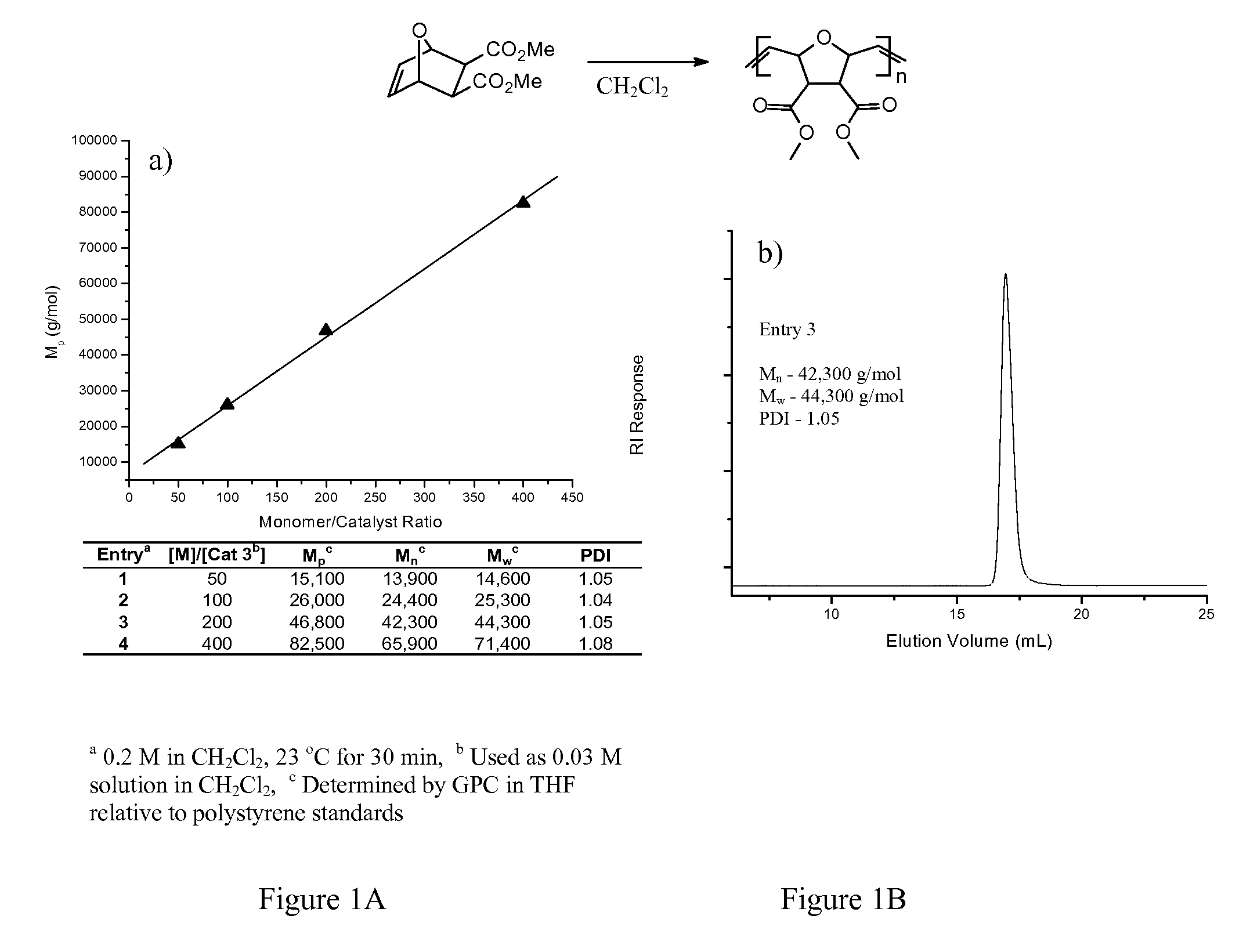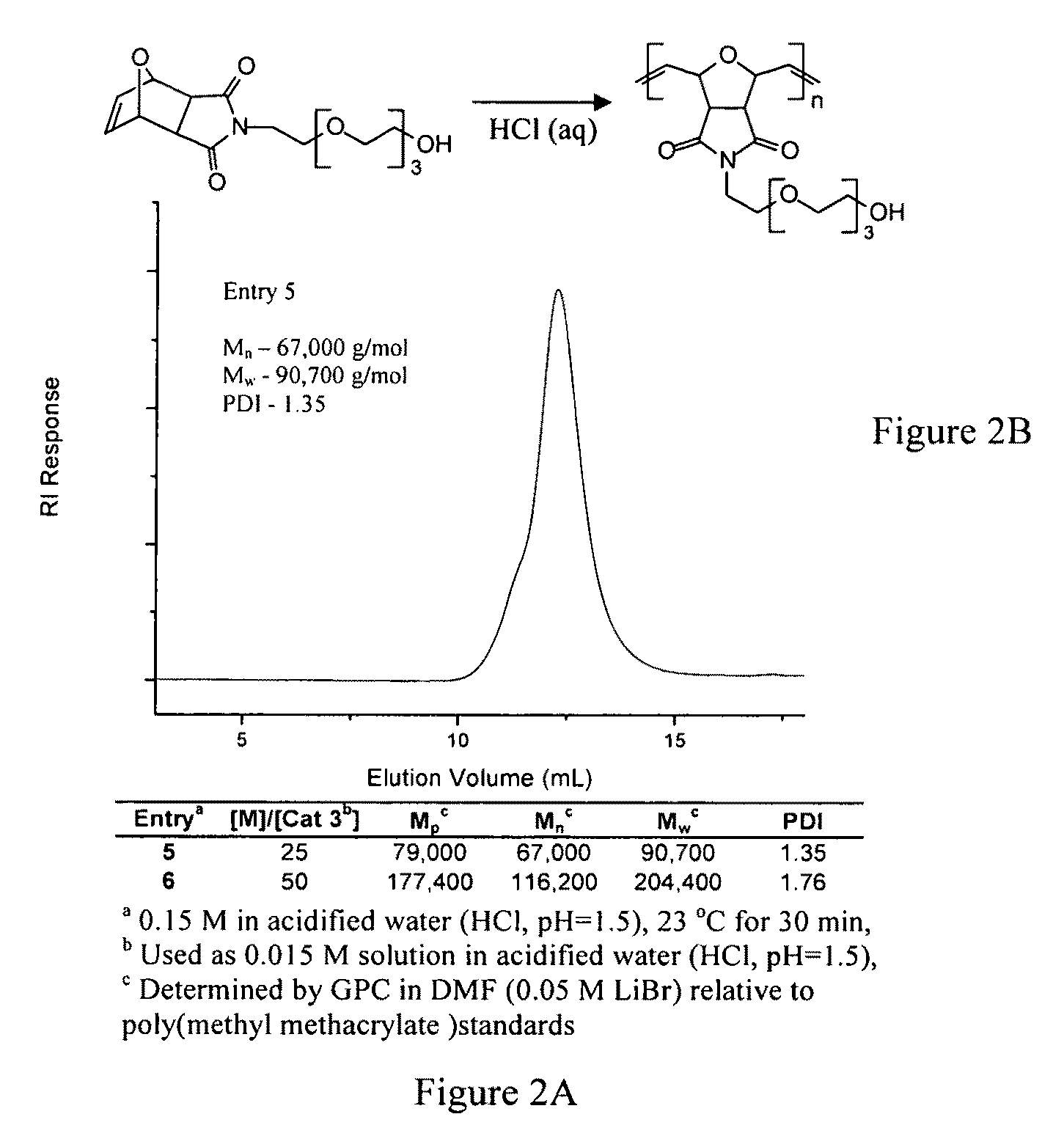Substituted pyridine ligands and related water-soluble catalysts
a technology of substituting pyridine ligands and water-soluble catalysts, which is applied in the direction of organic-compound/hydride/coordination-complex catalysts, physical/chemical process catalysts, ruthenium organic compounds, etc., can solve the problem of lack of catalyst versatility, and achieve good product yield or polymer conversion
- Summary
- Abstract
- Description
- Claims
- Application Information
AI Technical Summary
Benefits of technology
Problems solved by technology
Method used
Image
Examples
example 1a
[0058]Representative synthesis of PEG-pyridine ligand (compound 2 in Scheme 1, n=2). In a dry, round-bottom flask, 4-hydroxypyridine (3.00 g, 31.5 mmol), triphenylphosphine (8.7 g, 33 mmol), and triethylene glycol (14.2 g, 94.6 mmol) were combined and diluted in 100 mL dry THF. The flask containing this mixture was cooled in an ice-water bath (ca. 0° C.), and diisopropylazodicarboxylate (6.40 mL, 33.1 mmol) was injected. After 30 minutes, the ice bath was removed and the mixture was stirred under an atmosphere of nitrogen for 12 hours at room temperature. The mixture was concentrated and dissolved in ether. The product was extracted three times with 1 M HCl(aq). The combined aqueous fractions were treated with aqueous NaOH solution until a pH of 12 was reached. The product was then extracted with chloroform, and the combined organic fractions were dried over MgSO4 and concentrated by rotary evaporation. This crude product was purified by column chromatography over silica gel using c...
example 1b
[0059]With reference to Scheme 1, compound 1 is prepared in an analogous manner from 3-hydroxypyridine. Without limitation, both compounds 1 and 2 can vary by chain length (e.g., n can be from 2 to about 10 or greater), and / or terminal moiety (e.g., amino, alkyl, etc.). See more specifically, examples 1c-1f below.
example 1c
[0060]Synthesis of triethylene glycol substituted pyridine (2-{2-[2-(Pyridin-4-yloxy)-ethoxy]-ethoxy}-ethanol). To a dry, round-bottom flask was added 4-hydroxypyridine (5.00 g, 52.6 mmol), triphenylphosphine (20.68 g, 78.9 mmol), triethylene glycol (23.7 g, 157.8 mmol), and dry THF (125 mL). The mixture was stirred under N2(g) at 0° C., and diisopropyl azodicarboxylate (10.69 mL, 55.2 mmol) was added by addition funnel over 30 minutes. This mixture was stirred for 30 minutes, then the ice bath was removed, and the mixture was stirred under N2(g) for 12 hours at room temperature. The mixture was then concentrated, dissolved in chloroform, and extracted with 1 M HCl(aq). The combined aqueous fractions were treated with a 30 wt % NaOH solution until a pH of 12 was reached. The product was extracted three times with chloroform, and the combined organic fractions were dried over MgSO4 and concentrated. The product was purified first by silica gel chromatography (9:1 CHCl3:MeOH). Next, t...
PUM
| Property | Measurement | Unit |
|---|---|---|
| Fraction | aaaaa | aaaaa |
| Fraction | aaaaa | aaaaa |
| Fraction | aaaaa | aaaaa |
Abstract
Description
Claims
Application Information
 Login to View More
Login to View More - R&D
- Intellectual Property
- Life Sciences
- Materials
- Tech Scout
- Unparalleled Data Quality
- Higher Quality Content
- 60% Fewer Hallucinations
Browse by: Latest US Patents, China's latest patents, Technical Efficacy Thesaurus, Application Domain, Technology Topic, Popular Technical Reports.
© 2025 PatSnap. All rights reserved.Legal|Privacy policy|Modern Slavery Act Transparency Statement|Sitemap|About US| Contact US: help@patsnap.com



